| << |
1 |
2 |
3 |
4 |
5 |
6 |
7 |
8 |
9 |
10 |
11 |
12 |
13 |
14 |
15 |
16 |
17 |
18 |
19 |
20 |
21 |
22 |
23 |
24 |
25 |
26 |
27 |
28 |
29 |
30 |
31 |
5/1/2006 Worms of the Deep
By Robin Floyd
|
Today
it’s my turn to say a bit about myself and why
I’m here on board the Discovery. Actually this
is a question I’ve asked myself a few times,
considering I’m one of the few people here with
pretty much no experience in marine biology or oceanography,
and who has never been to sea before; finding myself
aboard a research vessel in some of the remotest waters
of the world is not something I ever expected. By
training I’m a molecular biologist (meaning
that I work with DNA), with a particular interest
in applying DNA-based techniques to studying the biodiversity
of small and obscure animals. My PhD was on nematode
worms in agricultural soil, for which my fieldwork
never took me further than 60 miles from Edinburgh.
|
Then, as I was finishing
my thesis, the British Antarctic Survey and the Natural
History Museum were beginning a collaborative project
to study the nematodes living in deep-ocean mud. I
was employed as a postdoc at BAS, and that, to cut
a long story short, led me here to collect samples,
along with Margaret Packer and Adrian Glover from
the NHM, who are involved in the same project. |
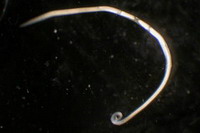 An unidentified nematode from
one of our samples (photo courtesy
of Adrian)
An unidentified nematode from
one of our samples (photo courtesy
of Adrian) |
|
So why
are we interested in nematode worms? Well, they may
be small (around 1mm long on average), but they have
strength in numbers. A typical square metre of topsoil
may contain a million individuals. Similar numbers
seem to exist in marine sediments (though far less
is known about distributions there), and when one
considers that seven tenths of the Earth’s surface
is covered by water, and much of the remainder by
soil, it becomes clear that nematodes must account
for a substantial fraction of all animals on the planet.
|
| In variety of species,
too, they surpass all other animal groups (with the
possible exception of insects) – though all
nematodes share the same basic body plan, they have
evolved into a wide range of forms, filling many different
ecological niches. There are around 12,000 described
nematode species, but this is undoubtedly an underestimate
of the real number, since every survey of a new environment
unveils a multitude of new ones; the true total is
likely to run into the millions. |
| Why does
this matter? If there’s a common thread that
ties together all of the disparate research activities
we’re doing on this voyage, it’s understanding
natural ecosystems, the varieties of life which make
them up, the cycle and flow of nutrients and energy
from one level to another. Given the rate at which
human activity is altering natural processes, we consider
it important to understand these systems, given that
we all depend on them for our survival. What we know
about nematodes, put simply, is that there are a lot
of them, they eat a lot of different things, and a
lot of different things eat them. |
|
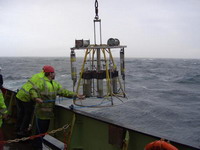
The megacorer, on a day when it decided to bring up
some material… |
This makes them a significant
component of ecosystem function, one about which relatively
little is known compared with other groups. Therefore
we wish to know more; however, those numbers I mentioned
earlier should give some idea of just how difficult
it is in practice to build a realistic picture of
how many species exist and how they are distributed.
The problem is exacerbated by the fact that nematode
taxonomy - the identification of individuals to species
by examining their physical features down a microscope
- is extremely difficult and laborious. |
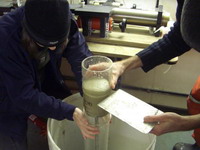 Adrian and Margaret slicing a
core into horizontal sections
Adrian and Margaret slicing a
core into horizontal sections |
Hence,
DNA barcoding, which is my particular specialist subject.
Rather than identifying an animal by its morphology,
it is possible to read a particular segment of its
genome, then, by comparing many such segments from
different individuals, to use that information to
tell us how many types are present; this is potentially
far more rapid than traditional taxonomy (though the
DNA approach has pitfalls of its own, but that’s
another story). The hope is that this will enable
us for the first time to generate some broad-scale
data on nematode biodiversity, especially in environments
such as the deep ocean where they have seldom been
studied before, and to begin to answer some of those
basic evolutionary and ecological questions. |
| So
that in essence is why I’m here, braving the
cold and the waves, sifting through mud from 4000
metres below, and trying to do molecular biology in
a lab which is constantly rolling from side to side.
Of course, the main part of the DNA work will be done
back on land; Margaret and I are really only collecting
and preserving the animals while we’re on ship.
I’ve been learning some microbiology as well
– when I haven’t had any nematode material
to work with (that megacorer is a temperamental thing),
I’ve been assisting my BAS colleagues David
Pearce and Rachel Malinowska with their work on seafloor
bacteria. All in all, I may have found myself somewhere
I never expected to be, but I wouldn’t be anywhere
else. |
|
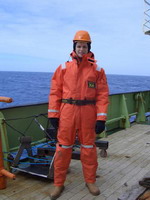
Me, on deck
|
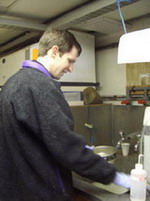
Me, sieving for worms |
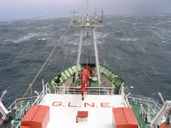 |
|